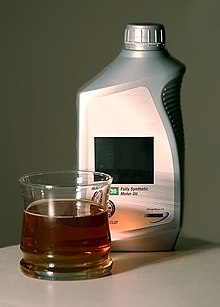合成潤滑油

合成潤滑油,是潤滑油的一種,使用於內燃機潤滑時或稱合成機油,指全部或部分使用合成基礎油作為配方中的基礎油的潤滑油,通常與礦物精煉潤滑油相對。
發展歷史[編輯]
早期合成潤滑油[編輯]
1930年代,德國法本公司化學家Dr. Hermann Zorn[1]開始研究具有天然石化油特性,但在低溫環境不易結凍的潤滑油,他的研究結果導致1930年代末和1940年代初3500多種酯被製造出來,包括雙基酸酯、多元醇酯和乙酸異戊酯。二戰期間,納粹德國空軍由於原油來源的缺乏及性能需求,在部分飛機發動機使用己二酸酯與聚合的烯烴/乙烯混合的合成潤滑油。[2]1944年3月起,美國陸軍航空隊由於冬天較易啟動、及大幅減少了油冷排中的油泥沉積,亦在部分飛機發動機使用以聚乙二醇為主的合成潤滑油。
合成潤滑油論戰[編輯]
嘉實多(Castrol)公司和美孚(Mobil)公司關於何謂"合成"潤滑油的商務論戰。起因1995年國際汽車工程師學會(SAE)從其Information Report J357文件中刪除了關於"合成"潤滑油的物理及化學定義,美國石油學會(API)亦從其API 1509文件中刪除了原本將"合成"基礎油定義為API Group IV/V的描述。嘉實多從1998年起在其內燃機潤滑油產品配方中使用氫化裂解(Hydrocracked)工藝製成的API Group III基礎油代替原來配方中的PAO(聚a-烯烴)基礎油,並宣稱其產品為"合成"潤滑油,而觸犯美孚當時作為世界上最大的PAO基礎油供應商的利益因而引起爭端。作為最大的PAO基礎油製造商,美孚認為只有使用PAO或酯類基礎油才能稱為"合成"潤滑油,而嘉實多的產品僅僅是礦物油的變種,美孚向商業促進局(Better Business Bureau)所屬的全國廣告司(National Advertising Division)投訴嘉實多從事虛假廣告。嘉實多則反駁1995年SAE和API都刪除了其文件中關於"合成"潤滑/基礎油的定義。1999年3月,商業促進局所屬的全國廣告司裁定嘉實多未欺騙消費者,嘉實多贏得實際上的勝利。自此使用API Group III作為基礎油的潤滑油在除德國之外[3]大部分國家可商業宣傳為"合成"潤滑油。而進入21世紀後,美孚亦開始在其部分合成潤滑油產品中加入API Group III基礎油(即美孚MSDW或AGC-21基礎油),作為全合成(部分美孚1號、Super Synthetic)或半合成潤滑油產品銷售。
近代合成潤滑油[編輯]
1973至1990年,荷蘭皇家殼牌公司研發出以費托合成(Fischer–Tropsch process)製成的氣轉液(Gas to liquids,GTL)基礎油,稱為Shell Middle Distillate Synthesis(SMDS)製程,API基礎油分類為Group III[4],成本遠低於PAO,且大部分的性能介於傳統API Group III與PAO之間。1980年代起美孚亦研發了類似的AGC-21製程基礎油。
合成油性能[編輯]
使用合成機油的優點包括在極端工作溫度下具有更好的低溫和高溫粘度性能[5], 更好(更高)的黏度指數 (VI)[6], 以及化學和剪切穩定性[7]。這也有助於減少蒸發造成的損失[6][8][9][10]。 它可以抵抗氧化、熱分解和油泥問題[11],並延長換油周期,減少使用過的廢油產生的環境效益。它在極端寒冷的條件下提供更好的潤滑[6]。使用合成油可能會延長發動機壽命[6],並具有出色的保護作用,可防止發動機熱點(特別是渦輪增壓器和機械增壓器)中的「灰燼」和其他沉積物形成,從而減少機油燃燒並降低損壞機油通道的機會堵塞[5]。由於發動機內部阻力較小,汽車的性能隨着馬力和扭矩的淨增加而得到改善[11]。 此外,它可以提高燃油效率 - 車隊測試記錄提高了1.8%至5%[6]。
參見[編輯]
參考文獻[編輯]
- ^ Eilhard Jantzen: The Origins of Synthetic Lubricants: The Work of Hermann Zorn in Germany, Part 1, Basic Studies of Lubricants and the Polymerisation of Olefins, Journal of Synthetic Lubrication, 12. 1996, Nr. 4, S. 283-301.
- ^ M.E. Spaght, German Aircraft Oils were made by Polymerization of Olefins Petroleum Processing, October 1946, p. 126-135
- ^ Urteil des I. Zivilsenats vom 21.6.2018 - I ZR 157/16 -. juris.bundesgerichtshof.de. [2019-09-25]. (原始內容存檔於2021-03-05).
- ^ American Petroleum Institute, Industry Services Department, Engine Oil Licensing and Certification System, API Publication 1509, 15th ed. April 2002
- ^ 5.0 5.1 Synthetic oil vs. conventional oil | Mobil™ Motor Oils. mobiloil.com. [2017-03-24]. (原始內容存檔於2019-03-21) (英語).
- ^ 6.0 6.1 6.2 6.3 6.4 Synthetic Motor Oil - GM High Tech Performance Magazine. Super Chevy. 2002-01-01 [2017-03-24]. (原始內容存檔於2021-04-28) (美國英語).
- ^ Markova, L. V.; Makarenko, V. M.; Kong, H.; Han, H. -G. Influence of viscosity modifiers on the rheological properties of synthetic oils. Journal of Friction and Wear. 2014, 35 (5): 351–358. S2CID 110320631. doi:10.3103/S1068366614050092.
- ^ Synthetic verus Mineral Fluids in Lubrication | A. Jackson | Mobil Research and Development Corporation | December 1987 | Page 7 Figure 5. Comparison of the volatility (ASTM D1160) of polydecene and mineral-based SAE 10W-30 oils. (PDF). [2023-01-28]. (原始內容存檔 (PDF)於2017-08-30).
- ^ Development and Application of a Lubricant Composition Model to Study Effects of Oil Transport, Vaporization, Fuel Dilution, and Soot Contamination on Lubricant Rheology and Engine Friction by Grace Xiang Gu B.S., Mechanical Engineering University of Michigan, 2012 | Page 96 … due to high temperatures near the top dead center of the piston, light volatile hydrocarbons vaporize and leave the system. Light carbon number species disappear at a faster rate due to their high volatility and vaporization rates. | Page 64 Figure 5-4: Viscosity curve for two different grades of oil using the Walther's formula | Page 68 Figure 5-5: Oil species boiling point and molecular weight. (PDF). [2023-01-28]. (原始內容存檔 (PDF)於2022-04-12).
- ^ Oilap
- ^ 11.0 11.1 Why Use Premium Synthetic Motor Oil? Premium Synthetic Oil vs. Standard Oil. Royal Purple. [2017-03-24]. (原始內容存檔於2018-10-15) (美國英語).
| |||||||||||||||||||||||||||||||||||||||||||||||||||||||||||||||||||
